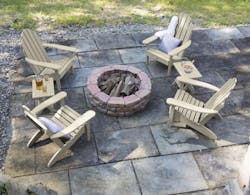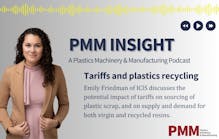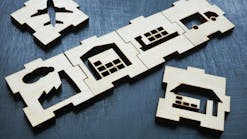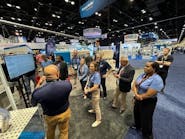Homework: Pandemic spurred backyard renovations, plastic decking sales
As the early days of the pandemic kept Americans close to home, many took stock of their surroundings and decided to make some changes. According to Lowe’s, beginning in the first quarter of 2020 it saw increases in sales in many categories within its stores. “Backyards, patios and balconies have become an escape customers are looking for, which … led to an uptick in outdoor projects.”
This new demand extended to plastics processors making products for those outdoor spaces. Jon Skelly, senior VP of strategy and execution at AZEK Co., which manufactures coextruded decking products under the TimberTech brand, said there was already a growth trend for his company.
“If you look at the rate of growth for decks across the United States … you’ve seen a rate of growth there in the 4- to 5-percent range, which is substantially higher than GDP. Our products have been growing at almost two times the rate of growth of the overall decking market — so high single digits.”
Skelly said that in the early days of the pandemic, the entire industry felt the effects of stay-at-home orders and other restrictions. “So, once that happened, we did experience a temporary slowdown. But what was odd was, shortly thereafter, we started to really see a massive amount of digital engagement with consumers,” Skelly said.
Normally, about 4 million consumers per year engage with the company online. “We expect that that rate’s going to double this year … we saw a really large spike as people were sitting at home and looking at, you know, the paint chipping or the deck rotting or whatever it might be. Visitors to the website began ordering samples, used the deck designer tool and requested quotes.”
John Quarmley, CEO of Highwood USA, which makes synthetic wood outdoor furniture and home and garden accessories like pergolas, said his company also saw demand rise. “Our plan for 2020 was for strong growth, and Q1 was shaping up nicely. As COVID took hold, we braced for the worst; however, demand in the consumer segment really shot up,” in late May. Quarmley went on to say that the consumer segment and backyard furniture “…has been surprisingly strong, and remains so.”
This urge to make home more comfortable also led to a surge in sales for home improvement chains in the second quarter. Lowe’s reported net earnings of $2.8 billion, compared to the $1.7 billion it reported in the same quarter of 2019, and it saw sales of $27.3 billion, compared to $21 billion for the second quarter of 2019.
Meanwhile, Home Depot reported net earnings of $4.3 billion, compared to $3.5 billion in the same quarter of 2019, with sales of $38.1 billion for the second quarter, compared to $30.8 billion for the second quarter of 2019.
Decking market is evolving
Skelly said that 10 years ago, about 90 percent of the decks constructed in the U.S. were built with wood, but today, that number has dropped to about 80 percent. He said more homeowners are being swayed by the longer life and lower maintenance requirements of polymer decks.
He said selling outdoor products has turned out to be an advantage during the pandemic.
“What benefited us [in the early days of the pandemic] is, given that these are outdoor spaces … people were comfortable … whereas maybe I wouldn’t feel comfortable having a contractor come over to look at redoing my kitchen because I just don’t want, you know, strangers in my home during a pandemic,” he said.
TimberTech offers two main coextruded products. “We have capped composite, which is … a mixture of polyethylene plastic and recycled wood, and then we cap it with a polyethylene cap,” Skelly said. “Our PVC product [is] a PVC core, some mixture of recycled and virgin PVC plastic and then that is capped as well on all four sides.”
Skelly described the differences between his company’s decking materials: “So the first thing that’s most notable to a consumer is the weight. And so again, since the capped composite product has wood fiber in it, it’s denser and heavier … the PVC is lighter and has less mass, it’s going to … dissipate heat better than that capped composite product,” he said. That leads to the PVC material selling better in hotter regions of the country. Also, the capped composite is denser and requires pre-drilling during installation, while the PVC product doesn’t.
Skelly said that because the PVC boards are lighter, TimberTech recently introduced wider boards to add design flexibility, responding to a trend for multi-width flooring. However, there are no plans to offer the wider boards for the capped composite. A typical deck-building crew is two people, and the weight could become unmanageable.
“If you were to make a wide width capped composite board and it was 16 feet long, you’d need four guys who work out to carry it, right?” Skelly joked.
Skelly said the PVC products can mimic exotic woods, and said of the premium Vintage product line, “You can't tell the difference between a mahogany board and one of our deck boards. It looks the same,” he said. “We have a product, weathered teak, that looks just like teak, we have a product that looks just like weathered ipe [a Brazilian hardwood]. The visuals are stunning.”
“On the capped composite side … the way you can grain those products is pretty interesting, so you tend to see a more aggressive grain pattern or embossed pattern on those. So, we launched a product last year called Reserve and we used the ability with the grain, with the colors, it looks sort of like a distressed barn … and we’ve had really strong consumer reaction to that and really good sales of that product this year because it’s just got this unique kind of weathered look.”
Describing his company’s products, Quarmley said, “Highwood produces a foamed, extruded synthetic wood product via profile extrusion. It is made from a range of styrenics, and is typically at least 50 percent scrap/recycle. The foam extrusion process does generate a skin on the surface.”
Highwood’s product line includes Adirondack chairs, benches and porch swings, with an appearance that mimics wood, including an embossed grain pattern.
Ramping up to meet the need
Both companies have taken additional steps to meet the demand.
“We’ve been regularly adding people, adding new machinery, adding capacity,” AZEK’s Skelly said. “Pre-pandemic, we announced publicly that we were going to invest an additional $100 million of capital to further expand our business and capacity. … We’ve upped that to approximately $180 million. So, it was a substantial investment before the pandemic, and it’s now even more substantial. And again, we feel really good about the long-term growth potential for our business and for industry because … 80 percent of the decking market is still wood, and so we think there’s a tremendous opportunity … to get a much bigger share of that … and convert them to our materials.”
Rising demand led Highwood to draw employees from multiple divisions to field customer service calls and online chats. “Highwood has been on a strong growth curve for several years now, and we expect to sustain that for several more … so we have accelerated plans to increase staffing,” Quarmley said.
However, he said finding the right employees has been a struggle. “For the past few years — at every manufacturer — this has been a challenge, and COVID has not changed it. … It’s difficult to staff open positions, and so far, the higher unemployment rate has not eased that situation — while, conceptually, it should.” To make up for the labor gap, Highwood has offered lots of overtime, which he said was the “only lever we have in the very-short term.”
Quarmley said his company has also made other adjustments. “We have been methodically working on automation projects as we have grown, and those will continue on pace.”
While some sectors saw supply chain disruptions, Quarmley said his company hasn’t suffered any supply challenges so far.
Supply chain issues didn’t affect AZEK, either — perhaps in part because it is its own resin supplier. In April 2019, it opened a 103,000-square-foot facility in Wilmington, Ohio, that turns PE bales into recycled resin for its TimberTech products. And in February of this year, AZEK acquired Ashland, Ohio-based Return Polymers, which had supplied AZEK with PVC.
“Only 2 percent of our sales are outside of the U.S. and Canada, and all of our manufacturing operations are here in the U.S.,” Skelly said. “Our largest raw material is recycled plastic waste and in addition to other materials we use in our products … it’s almost all sourced from United States … so we were fortunate not to feel an impact on that.”
Seeking stability for the long haul
Skelly said sustainability is important to AZEK. “We started the journey in 2018 to make recycling a really important part of who we are. It’s core to who we are, it’s core to our values and our purpose is that we wanted to be a sustainable building products company,” he said. “So, we started by doing the research and development to utilize … recycled waste within our products. So, we did that at first by buying already processed recycled material and putting it into our decking products in our trim products.”
“That was the first step, and then once we trialed that and were comfortable that we could maintain or improve the visuals and the quality of our products using recycling, we took the next step and that was ‘let’s vertically integrate, let’s actually start to recycle our own material’ so instead of buying it processed, we’ll do the processing,” Skelly said. “And so, we opened [the Wilmington facility] that’s a polyethylene recycling facility, so that’s where we’re taking in those plastic bags and those bottles and we’re grinding it up, processing it and turning it into raw material for our decking and trim products.
“And then Return Polymers, they were a supplier of recycled PVC for us, and so they were somebody who we were buying recycled PVC from already, and so we completed that acquisition to vertically integrate the PVC plastics side of our business. So, now we have both polyethylene and PVC recycling capabilities in house.
“Again, we buy the garbage if you will, we buy the waste, process it, and we put it into our materials. That was all pre-pandemic, but in terms of again, part of our value proposition post-pandemic, you know as people look at their outdoor living spaces and they think about ‘Hey, I want to build a deck,’ and they have to choose between a higher-end wood that maybe came from the rainforest or something that’s not sustainable versus our product, which is a sustainable recycled product. We think that gives us an advantage as people look at those investments in their outdoor living,” he said.
Skelly said that while AZEK has invested in digital tools to help customers with do-it-yourself projects, as well as providing a directory to find local professionals, it haven’t been able to track how its website visitors end up completing their projects.
“What we don’t know and what we’d love to know is how many people start to do it themselves and then pull the plug, quit and then hire a contractor to fix what they screwed up because it’s not as easy as it looks, I can tell you,” Skelly said.
“One of my best friends in the world is a contractor, and you know he just he loves the call when somebody screwed something up, because he knows he can kind of name his price just to get the husband out of the mess he’s put himself into.”
Looking forward, demand for decking products could extend into the winter months. “Typically, in the U.S., your prime season [is] April to October,” Skelly said. “But then you can look at what we call the ‘smile states’ — the Carolinas, Florida, Texas up into California, you know that season … will run more year-round,” he said.
Quarmley said he sees signs the higher demand is not ready to slow down. “The year continues to be ‘unusual’ … and I fully expect this will continue through Q3 2021,” he said. “Order volume is much higher than normal; consumer spending on the home appears to be quite strong. All signs suggest that people will continue to ‘nest’ over the coming year and focus on home improvements.”
David Tillett, associate editor
For more information:
Highwood USA LLC, Hometown, Pa., 570-225-7501, www.highwood-usa.com
AZEK Co. LLC, Chicago, 877-275-2935, www.timbertech.com
David Tillett | Associate Editor
Associate Editor David Tillett writes and edits for Plastics Machinery & Manufacturing, Plastics Recycling and The Journal of Blow Molding. He covers new products, industry news, patents and consumer and business equipment. He has more than 20 years of experience in daily newspaper, online and magazine journalism.






